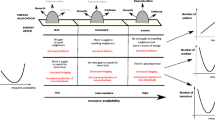Abstract
The adaptation of nest size to its population is one of the most common processes, but little is known about the dynamics nest-building and -enlarging in social context. Furthermore, the mechanisms involved remain totally ignored. We present here the first results of such dynamics in the context of Lasius niger's nest excavation. We find, with an artificial but standardized method, a strong positive correlation between the number of ants and the final nest volume as well as the digging rate. Both grow almost proportionally to population. When the number of individuals is artificially increased (even slightly) in a nest, its dimension is systematically adjusted in the same way as initial excavation. In this process, digging acts as a negative feedback that controls nest enlargement. Experiments revealed that this negative control is due directly to the volume of the nest as well as the physiological or behavioral modification of ants after digging. Finally, amplification of activity was observed during the enlargement phase, suggesting the possible implication of self-organized processes in the volume control mechanism.
Similar content being viewed by others
REFERENCES
Bathkhar, A. P., and Withcombs, W. H. (1970). Aritifical diet for rearing various species of ants. Fla. Entomol. 53(4): 229-232.
Bonabeau, E., Theraulaz, G., and Deneubourg, J. L. (1996). Quantitative study of the fixed threshold model for the regulation of division of labour in insect societies. Proc. R. Soc. Lond. 263: 1565-1569.
Bonabeau, E., Theraulaz, G., Deneubourg, J. L., Aron, S., and Camazine, S. (1997). Selforganization in social insects. Tree 12: 188-193.
Bonabeau, E., Theraulaz, G., Deneubourg, J. L., Franks, N. R., Rafelsberger, O., Joly, J. L., and Blanco, S. (1998). The emergence of pillars, walls and royal chambre in termite nests. Philos. Trans. R. Soc. London Ser. B (in press).
Brian, M. V. (1983). Social Insects: Ecology and Behavioural Biology, Chapman and Hall, London.
Bruinsma, O. H. (1979). An Analysis of Building Behaviour of the Termite Macrotermes subhyalinus, Ph.D. thesis, Landbouwhogeschool te Wageninge, The Netherlands.
Burkhardt, J. F. (1998). Intividual flexibility and tempo in the ant, Pheidole dentata, the influence of group size. J. Insect Behav. 11: 493-505.
Camazine, S., Deneubourg, J. L., Franks, N. R., Sneyd, J., Bonabeau, E., and Theraulaz, G. (2001). Self-Organization in Biological Systems, Princeton University Press, Princeton, NJ (in press).
Collins, N. M. (1981). Population; Age structure and survivorship of colonies of Macrotermes bellicosus (Isoptera, Macrotermitinae). J. Anim. Ecol. 50: 293-311.
Darchen, R. (1959). Les techniques de construction chez Apis mellifica, Thè se sciences, Paris.
Deneubourg, J. L. (1977). Application de l'ordre par fluctuations à la description de certaines étapes de la construction du nid chez les termites. Insectes Soc. 24: 117-130.
Deneubourg, J. L., and Franks, N. R. (1995). Collective control without explicit coding: The case of communal nest excavation. J. Insect Behav. 4: 417-432.
Deneubourg, J. L., and Goss, S. (1989). Collective patterns and decision making. Ethol. Ecol. Evol. 1: 295-311.
Fewell, J. H., and Page, R. E. (1999). The emergence of division of labour in forced associations of normally solitary ant queens. Evol. Ecol. Res. 1(5): 537-548.
Franks, N. R., and Deneubourg, J. L. (1997). Self-organizing nest construction in ants: Individual workers behaviour and nest's dynamics. Anim. Behav. 54: 779-796.
Franks, N. R., Wilby, A., Silverman, B., and Toft, C. (1992). Self-organizing nest construction in ants: Sophisticated building by blind buldozing. Anim. Behav. 44: 357-375.
Gallé, L. (1978). Respiration as one of the manifestations of the group effect in ants. Acta Biol. Szegd. 24(1-4): 111-114.
Gordon, D. M., Paul, R. E. H., and Thorpe, K. (1993). What is the function of encounter patterns in ant colonies? Anim. Behav. 45: 1083-1100.
Grassé, P.-P. (1959). La reconstruction du nid et les coordinations inter-individuelles chez Bellicositermes natalensis et Cubitermes sp. La théorie de la stigergie: Essai d'interprétation du comportement des termites constructeurs. Insectes Soc. 6: 41-83.
Hangartner, W. (1969). Carbon dioxide, a releaser for digging behavior in Solenopsis geminata (Hymenoptera: Formicidae). Psyché 76(1): 58-67.
Hansell, M. H. (1984). Animal Architecture and Building Behavior, Longman Press, London.
Hölldobler, B., and Wilson, E. O. (1990). The Ants, Springer-Verlag, Berlin.
Kleindeidam, C., and Tautz, J. (1996). Perception of carbon dioxide on other “air-conditions” parameters in leaf cutting ant Atta cephalotes. Natuurwissenschafften 83: 566-568.
Lenoir, A. (1979). Le comportement alimentaire et la division du travail chez Lasiusniger. Bull. Biol. France Belg. 13: 2-3.
Lepage, M. (1974). Les termites d'une savane saharienne (Ferlo septentrional, Sénégal) peuplement, population, consommation, rô le dans l'écosystè me, Thè se sciences, Université de Dijon, Dijon.
Rasse, P., and Deneubourg, J. L. (2001). Collective decision-making during nest gallery excavation by the ant Lasius niger ((Hymenopterae, Formicidae) (in preparation).
Skerka, V., Deneubourg, J. L., and Belic, M. R. (1990). Mathematical model of building behavior of Apis mellifera. J. Theor. Biol. 147: 1-16.
Tschinkel, W. R. (1993). Sociometry and sociogenesis of colonies of the fire ant Solenopsis invicta during one annual cycle. Ecol. Monogr. 63(4): 425-457.
Tschinkel, W. R. (1999). Sociometry and sociogenesis of colonies of the Florida harvester ant (Hymenoptera: Formicidae). Ann. Entomol. Soc. Am. 92(1): 80-89.
Author information
Authors and Affiliations
Corresponding author
Rights and permissions
About this article
Cite this article
Rasse, P., Deneubourg, J.L. Dynamics of Nest Excavation and Nest Size Regulation of Lasius niger (Hymenoptera: Formicidae). Journal of Insect Behavior 14, 433–449 (2001). https://doi.org/10.1023/A:1011163804217
Issue Date:
DOI: https://doi.org/10.1023/A:1011163804217




